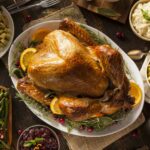How to Roast Turkey
Tips on how to roast a turkey for Thanksgiving. Including whether you should cover the turkey with foil and when to take the foil off.
Servings: 12 -15 servings
Calories: 628kcal
Ingredients
- 15 pound Turkey
- ½ cup butter softened
- Salt and pepper
- 2 tablespoons Poultry Seasoning
Instructions
The Night Before Thanksgiving:
- Remove the turkey from the packaging and remove the neck and giblets from the cavity.
- You can use these to make turkey stock if desired...I usually throw them away.
- Pat dry with paper towels.
- Place the turkey on a tray and cover with paper towels and aluminum foil and place in the refrigerator overnight.
Thanksgiving Morning:
- Remove the turkey from the refrigerator and uncover.
- Place the turkey, breast side up in the roasting pan on top of a rack.
- If you are roasting the turkey with stuffing, add your prepared stuffing now to the cavity of the turkey. If you are not stuffing the turkey, make sure you salt and pepper the cavity.
- You can also add onions, apples, celery, carrots and parsnips to the cavity of the bird. These will all add flavor to the turkey. Make sure you stuff loosely.
- Turn the wings back or under the bird. Using kitchen twine, truss the legs of the turkey together
- Cover the turkey with the softened butter, the more the better. This is Thanksgiving and calories don’t count.
- Sprinkle the turkey with salt and pepper and then poultry seasoning. If you prefer different seasonings, please use your favorite.
- Roast the turkey at 400 degrees for the first 20 minutes. Then lower the oven temperature to 325 degrees and continue cooking for another 3 to 4 hours.
- If you notice that the turkey is getting too brown while it is cooking, cover loosely with aluminum foil.
- Don’t forget to baste your turkey! I like to baste every 20 minutes or so using chicken stock.
- The turkey is done when a meat thermometer inserted into the thickest part of the turkey’s thigh reads 170 degrees.
- If you stuffed the turkey with dressing, the dressing should reach 165 degrees for it to be safe to consume.
- Once the turkey is finished cooking, remove it from the oven. Take the turkey out of the roasting pan and place on a cutting board. Cover the turkey with aluminum foil.
- Let the turkey rest for 30 to 60 minutes before carving.
Notes
Since first publishing this recipe post in 2015, there are new guidelines recommending not to rinse the turkey or any other poultry. You can read more about the new guidelines from the Food and Drug Administration.
Tips
- Prep the turkey the night before to save time and allow the skin to dry for a crisp finish.
- Season generously inside and out for the best flavor.
- Tent loosely with foil during roasting, then uncover for the last 30–45 minutes to brown the skin.
- Carve the turkey in advance and keep the slices covered with foil in a large pan until serving.
- Store leftovers in airtight containers in the refrigerator for up to 3–4 days.
- Freeze cooked turkey for up to 3 months; thaw overnight in the fridge before reheating.
Nutrition
Serving: 1Serving | Calories: 628kcal | Carbohydrates: 1g | Protein: 86g | Fat: 29g | Saturated Fat: 10g | Polyunsaturated Fat: 16g | Trans Fat: 1g | Cholesterol: 346mg | Sodium: 380mg
